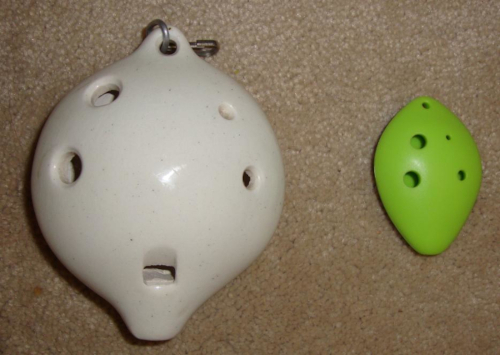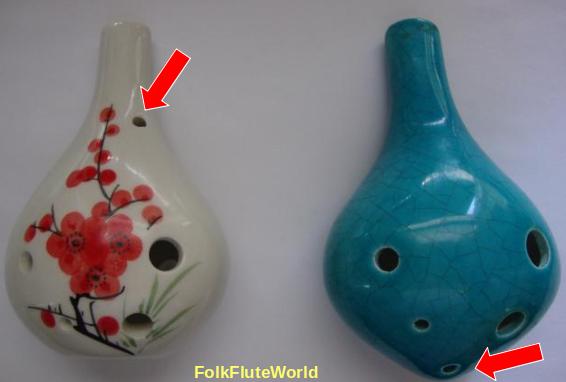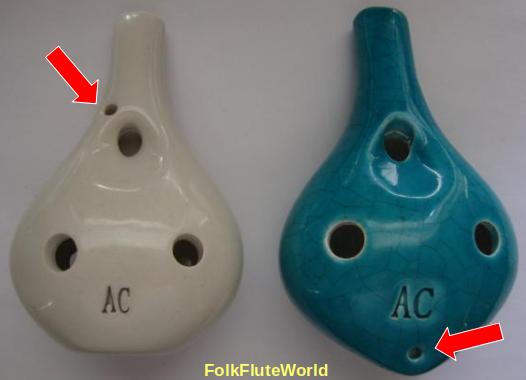How to Spot a Fake Flute
by Howard Fosdick © FolkFluteWorld.com

Ever been tempted to buy a flute when you can't try it first? On Ebay, Etsy, or some other website?
There's a risk to this. You might buy a fake flute -- an unplayable item.
Some are intended as fancy, decorated display pieces. This is a perfectly legitimate market. Many people enjoy collecting attractive artworks that look like flutes but aren't playable.
For example, take look at those two "flutes" to the left. They're beautifully embroidered.
But whatever flute you buy -- for whatever purpose -- you'll certainly want to know up-front that you're buying an display piece rather than a true musical instrument.
Beyond collectibles, there are also low-value fakes, made to look like a great buy for a musical instrument, but that are actually just designed to steal your hard-earned cash.
This article tells you how to distinguish an unplayable flute from the real thing.
Identifying Fakes
Playable flutes -- whether they're recorders, tin whistles, ocarinas, or vessel flutes -- have irregularly-spaced finger holes of varying sizes.
Flutes with evenly-space finger holes of all the same size are rarely playable.
Here are a few fake flutes. Note the evenly space finger holes, and how all the holes are the same size:

None of these flutes play a true scale
You can see why someone would want to collect these pleasing fancy flutes. Their intricate designs are appealing. But none plays a true musical scale.
Just for contrast, look at this wide variety of playable recorders, tin whistles, ocarinas, and other folk flutes. Every one of them features differently-sized finger holes of uneven spacing.

These flutes are all true musical instruments
Identifying Fake Ocarinas
Fake vessel flutes are popular among collectors. They like to display them for their colorful or unusual designs. I've seen collectible ocarinas representing every animal that exists, as well as many that don't (like unicorns, sea monsters, elves, dwarves, and the like.)
Many are made in Latin America or east Asia. Collecting these is a fun hobby that many enjoy.
Most of these pieces play a few notes. But they won't play an entire musical scale, and they don't play in tune. These are best termed whistles, instead of ocarinas or true vessel flutes.
Again, the dead giveaway that you're buying a whistle rather than a true musical instrument is by the symmetrical spacing of the same-sized holes. Here are a few examples:

Non-playable vessel flutes
Flutes That Play -- But Not in Tune!

Here's another problem to consider. Besides fake flutes -- those that were never designed to play music -- you also face the challenge of folk flutes that play, but not in tune.
Sometimes just a single note will sound out of tune. For example, the highest note the instrument can play.
In other cases, the instrument will have several ill-tuned notes. These might be off according to a tuning meter, or perhaps the flute doesn't play in tune with itself across the scale.
If the instrument is tunable -- like a recorder -- you might be able to adjust it to address the issue. But untunable instruments -- like ocarinas and most tin whistles -- offer no remedy.
There are only two ways to know for certain whether an instrument is fully in tune across its range:
- Play it in person
- Listen to a sound sample
In either case, make sure you've heard the full range of notes the instrument plays. Otherwise, you could discover that a note is out of tune only after your purchase the instrument.
Final Exam - Question #1
Okay, it's time for your final exam. Here's a photo from an authentic Ebay listing. Is this flute playable?

Ebay Offering: Playable or Not?
First off, notice that the listing poses this flute inside a Johannes Adler box labeled "The World's Finest Recorder." But look close, and you notice that this item has only 6 fingering holes on top. That's not a recorder. Recorders have 7 top holes (some of which may be double-holes).
6 holes indicates a penny whistle. So if anything, this is a penny whistle sitting in a recorder box with which it has no legitimate association.
Next, notice how each fingering hole is the exact same size, and how they are spaced equidistant from one another.
So this item is unplayable. You might buy it as a lovely collectible, but it is not a playable musical instrument. The seller may or may not have been aware of this fact.
By the way, I can verify this conclusion from experience. I bought a lot of a few dozen flutes at an estate sale, and this very item was included (without the box).
It's very pretty, but it doesn't play a note.
Final Exam - Question #2
Here's your second question. Are both, either, or neither of these ocarinas playable?


To start, look in the first photo to see if these "seedpod" or "pendant" style vessel flutes have four different-sized fingering holes on top.
Both do. So at first glance you might guess that these are both playable instruments.
Look closer at the first photo, though, and you see that both ocarinas have an extra 5th hole on their front side. The red arrows point to where these are located.
The second photo shows that these extra holes go all the way through from front to back.
If you had these pieces in hand, your next task would be to verify whether these 5th holes penetrate the vessel enclosure in which the ocarina's sound waves resonate.
You'd find that the 5th hole on the fancy-design ocarina penetrates the enclosure. So it's unplayable... no pendant ocarina has a 5th fingering hole on top.
The 5th hole in the blue ocarina does not penetrate the oc's enclosure. In fact, if you could peer closely at it, you'd see that actually it's a hole for stringing a necklace through. It has no bearing on the playability of this instrument.
The pretty painted oc is only for display. It's a cute collectible that won't play a scale. The blue oc is a true musical instrument.
Conclusion
There's an entire world of non-playable flutes and whistles designed as display pieces. If you like to collect them, enjoy! But always know what you're buying.
If you're looking for a musical instrument, now you know how to avoid non-playable collectibles. There are a lot of them out there!